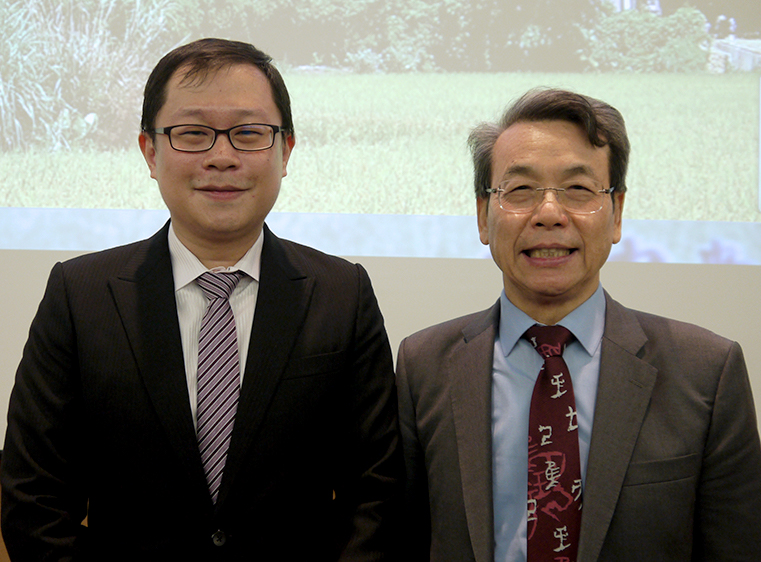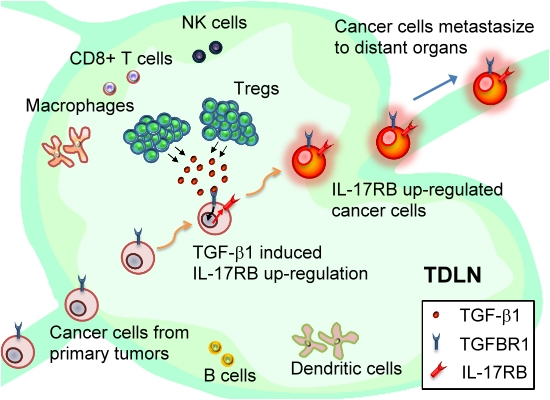When breast cancer cells are found in the lymph nodes, it is considered an important prognostic predictor for patient survival. However, whether tumor-draining lymph nodes (TDLNs) take parts in the course of breast cancer metastasis has never been thoroughly looked at. Dr. Wen-Hwa Lee’s team took the initiative and has concluded that TDLNs plays a crucial role for breast cancer malignancy.
The team demonstrated in a series of animal tests that inside TDLN a kind of immune cell named as Tregs (regulatory T cells) actually enhances the breast cancer malignancy.
Besides the cardiovascular system which distributes blood, there is the lymphatic system that circulates lymph. Together, they form the circulatory system as the transportation system to allow substances interchange inside our body. The lymphatic system is connected by lymphatic vessels. Compared to blood vessel, Lymphatic vessels are porous and easily accessed by cells. A much lower flow rate of lymphatic vessel takes advantage for increasing survival of cells by minimizing shear stress. Therefore, for cancer cells that long for a journey to other organs, lymph vessels are ideal channels.
 |
| Dr. Wen-Hwa Lee(right) and Dr. Shih-Chia Huang(left, first author of the research publication of this study) |
Lymph nodes are like checkpoints throughout the lymphatic system, it has all sorts of immune cells at duty to guard our body.
One would think the cancer cells should avoid the lymph nodes to protect itself from the immune system. However, Lee’s team noted a significantly higher metastatic ability was shown by breast cancer cells derived from TDLNs.
In reality, they have discovered that the Tregs cells which are supposed to guard abnormal immune behaviors would secret a molecule called TGF-β1. TGF-β1 then up-regulate IL-17RB expression, and IL-17RB is the gene that make breast cancer cells stronger to migrate to distant organs like lungs.
 |
| Schematic model of Tregs secreted TGF-β1 in TDLNs promote breast cancer malignancy via up-regulation of IL-17RB. |
According to Dr. Shih-Chia Huang, first author of the research publication of this study, axillary lymph node dissection has been adopted for Melanoma therapeutics and proved positive prognosis, the finding of Tregs enhancement clarifies the role of TDLNs in breast cancer distant metastasis. This can provide insights to the medical professionals.
This study was done by Dr. Wen-Hwa Lee’ team at Genomics Research Center, Academia Sinica and a collaborative effort with Physicians from National Taiwan University Hospitals, including Dr. Chiun-Sheng Huang, Dr. King-Jen Chang, Dr. Wen-Hung Kuo and Dr. Yung-Ming Jeng.
Extensive animal experiments were conducted in Genomics Research Center, from these tests, researchers concluded that the depletion of Tregs in TDLNs would end oncogenic IL-17RB induction as well as metastatic activities in breast cancer cells. It is more exciting to see that the removal of TDLNs at early stages would indeed reduce migrations of breast cancer cells to distant organs.
IL-17RB has been a target for cancer study in Lee’s lab, their pursuit in developing IL-17RB antibody looks promising for blocking breast cancer metastasis.
The paper entitled “TGF-β1 secreted by Tregs in lymph nodes promotes breast cancer malignancy via up-regulation of IL-17RB” has been published in the EMBO Molecular Medicine, Oct 9. 2017.